GENERATOR SAFETY FOR PORTABLE GENERATORS
BEFORE YOU OPERATE ANY GENERATOR YOU MUST BE FAMILIAR WITH ALL CONTROLS AND SAFETY REQUIREMENTS
READ THE MANUAL AND CAREFULLY EXAMINE ALL CONTROLS.
ALWAYS HAVE A FIRE EXTINGUISHER HANDY, JUST IN CASE. SAFETY FIRST!
ALWAYS THINK SAFETY. PROTECT YOURSELF AND EVERYONE AROUND YOU. SAFETY FIRST!
Become familiar with the generator by reading the owner’s manual before operation. Be sure that anyone who operates the generator receives proper instruction on its safe operation and has read the owner’s manual. Do not let children operate the generator without parental supervision.
The operator is responsible for the safe operation of the generator.
![]() Know how to stop the generator quickly in case of an emergency.
Know how to stop the generator quickly in case of an emergency.
![]() Understand the use of all generator controls, output receptacles and connections.
Understand the use of all generator controls, output receptacles and connections.
BE FAMILIAR WITH THE GENERATOR
Read the owners manual and safety precautions.
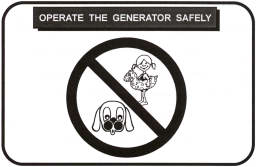
| Be Familiar With The Generator | |
|
|
Read the owner's manual. |
|
|
Instruct inexperienced persons on safe operation of the generator. |
|
|
Keep children and pets away from the generator while it is running. |
Don’t make modifications to the fuel or exhaust system.
Exhaust modifications can add stress to the original equipment exhaust system which can cause breakage resulting in exhaust leaks. Elbows in the modified exhaust system will create back pressure on the engine which reduces performance and shortens the engine service life.
Larger auxiliary tanks added
to the system will create more pressure on the inlet needle valve which
may cause the inlet needle to lose its ability to regulate the fuel flowing
into the carburetor. This may cause the crankcase engine oil to become diluted
with fuel, spark plug and spark arrestor carbon build-up, and possible external
fuel leaks which may result in fires.
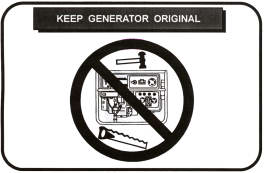
| Keep The Generator Original | |
|
|
Maintain the fuel system as original equipment. |
|
|
Maintain the exhaust system as original equipment. |
Don’t operate the generator inside a building, vehicle, or an enclosure.
The engine’s exhaust contains poisonous carbon monoxide. If you run the generator in an area that is confined, even partially enclosed, or if the exhaust is pointed toward a partially enclosed work area, the air you breathe could contain a dangerous amount of exhaust gas. To keep exhaust from building up, operate only in open areas and provide adequate ventilation.
The generator must
also breathe fresh air. Intake air for generator and engine cooling, and
combustion air must no be contaminated with engine exhaust.
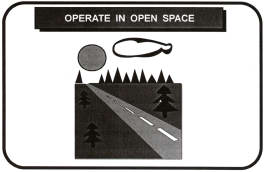
| Operate In The Open | |
|
|
Operate in open space. |
|
|
Aim exhaust outlet AWAY from working areas. |
|
|
Keep the area around the generator unobstructed for cooling and exhaust. |
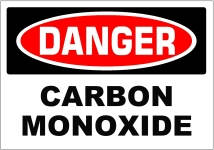
The generator produces enough electric power to cause a serious shock or electrocution if used in wet conditions. Water decreases the resistance between the appliance, the operator, and earth which increases the likelihood of electrical shock.
Using a generator or electrical appliance in wet conditions, such as rain or snow, or near a pool or sprinkler system, or when your hands are wet, could result in electrocution.
If the generator is
stored outdoors unprotected from the weather, check the Ground Fault Circuit
Interrupter (GFCI) receptacle and all other electrical components on the
control panel before each use. Moisture or ice can cause a malfunction or
short circuit in electrical components which could result in electrocution.
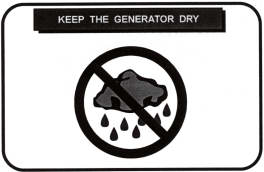
| Operate In Dry Conditions | |
|
|
Avoid operating the generator in rain or snow. |
|
|
Avoid operating the generator near a pool. |
|
|
Avoid operating the generator near a sprinkler system. |
|
|
Avoid operating the generator with wet hands, feet or clothing. |
Operate the generator on a level surface. If the generator is operated at an angel, the lubrication system may fail causing a lack of lubrication to the critical moving parts of the engine.
The carburetor fuel level may be changed to cause the float to stay open to allow fuel to flow into the carburetor bowl unrestricted. This could cause spark plug fouling, piston/cylinder washing, and crankcase oil dilution.
If the generator is operating on soft ground such as sand or soft soil, the generator will "dig in" creating an angle that will produce the same symptoms described above. If the angle becomes extreme, the generator may tip over.
If the generator is operated in sandy, dusty conditions, the discharged air from the generator end will stir up dust. The dust will be sucked up into the air cleaner, shortening its service interval. Dust will also be drawn in with the generator cooling air, sandblasting the windings of the rotor and stator.
If the generator must be
operated in loose or sandy surface conditions, place it on a piece of plywood
or a stable platform.
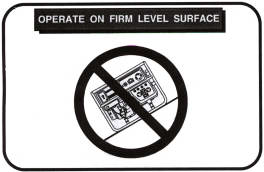
| Operate On Firm, Level Surfaces | |
|
|
Operate on a level surface. |
|
|
Operate on a firm surface. |
|
|
Operate away from dusty or sandy conditions. |
|
|
Operate in dry conditions. |
To be sure the generator is ready when you need it:
![]() The generator should be started and loaded at least once a month.
The generator should be started and loaded at least once a month.
![]() The fuel tank should be kept filled with fresh fuel. A fuel conditioner
should be used to keep the fuel from breaking down.
The fuel tank should be kept filled with fresh fuel. A fuel conditioner
should be used to keep the fuel from breaking down.
![]() A trickle charger should charge the battery monthly. The brief time
the generator is exercised may not be enough time to allow the generator’s
charging system to adequately charge the battery.
A trickle charger should charge the battery monthly. The brief time
the generator is exercised may not be enough time to allow the generator’s
charging system to adequately charge the battery.
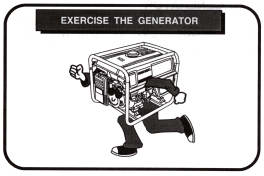
| Generator Readiness | |
|
|
Exercise the generator monthly under load |
|
|
Keep battery charged |
|
|
Keep tank filled with fresh fuel |
FILLING FUEL CANS
![]() FILL GASOLINE CANS ON THE GROUND,
NOT IN THE BED OF YOUR PICKUP OR SUV. It is
a known fact that static electricity builds up on plastic bed-liners in
trucks which then builds up on your gasoline cans. Put your gasoline cans
on the ground, touch a bare metal spot on the can with the gas nozzle to
discharge any static electricity, then open the can
and fill it.
FILL GASOLINE CANS ON THE GROUND,
NOT IN THE BED OF YOUR PICKUP OR SUV. It is
a known fact that static electricity builds up on plastic bed-liners in
trucks which then builds up on your gasoline cans. Put your gasoline cans
on the ground, touch a bare metal spot on the can with the gas nozzle to
discharge any static electricity, then open the can
and fill it.
![]() The very act of pouring gasoline generates static electricity. If
you transfer gasoline from cans to drums, use metal drums and metal cans.
Touch a bare metal area of the can to a bare metal area of the drum to discharge
any static electricity before you open them. If possible, make a short jumper
cable that you can attach to a bare metal part of each container before
you open them and start transferring the fuel.
The very act of pouring gasoline generates static electricity. If
you transfer gasoline from cans to drums, use metal drums and metal cans.
Touch a bare metal area of the can to a bare metal area of the drum to discharge
any static electricity before you open them. If possible, make a short jumper
cable that you can attach to a bare metal part of each container before
you open them and start transferring the fuel.
ALWAYS THINK SAFETY.
PROTECT YOURSELF AND EVERYONE AROUND YOU. SAFETY FIRST!
Please read the information on Transfer Switches.